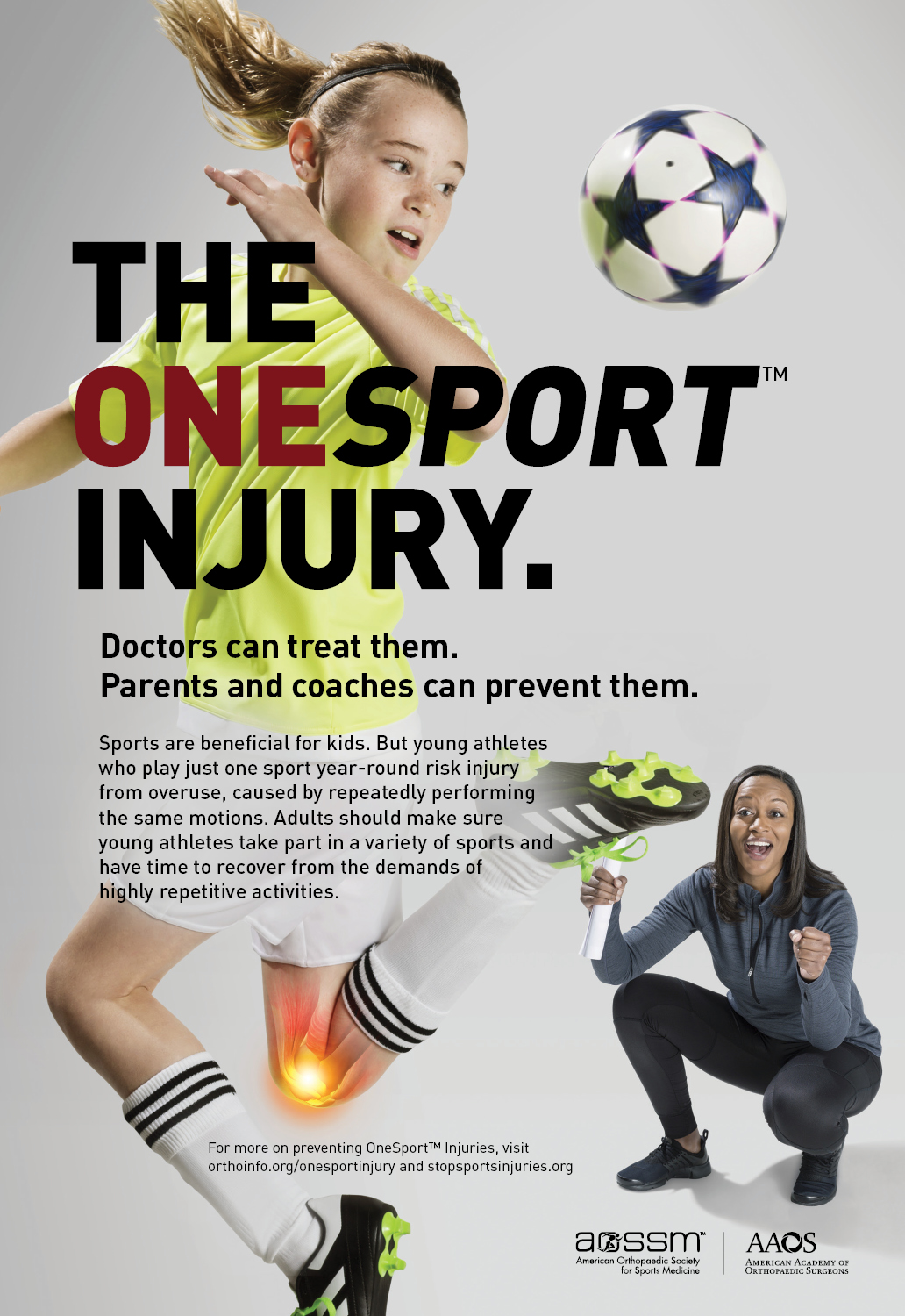The OneSport™ Injury
Doctors can treat them. Parents and coaches can prevent them.
Sports are a great way for young athletes to exercise and have fun. It’s also a way to learn about teamwork and develop discipline. But healthy competition is becoming unhealthy.
More and more young athletes under the age of 12 are focusing on just one sport, and training year-round. Sports specialization in youth is defined as engaging in a sport for at least three seasons a year at the exclusion of other sports. Kids who specialize early are more likely to develop overuse injuries because of repetitive movements, be stressed, and quit sports.[1]
Orthopaedic surgeons often treat sports-related broken bones and muscle injuries. But the American Academy of Orthopaedic Surgeons (AAOS) and the American Orthopaedic Society for Sports Medicine (AOSSM) want to help young athletes prevent overuse injuries. The OneSport™ campaign, which kicked off across media spaces nationwide in spring 2018, educates parents, coaches and young athletes about the dangers of early sports specialization.
Facts about Overuse Sports Injuries
- Overuse injuries in children happen gradually over time, but can have a lifelong effect on their game, health and quality of life.
- When a young child whose body is still growing and developing, and repeatedly participates in one type of athletic activity, their body does not have enough time to heal properly between resting and playing.
- Intense and repetitive training can lead to pediatric trauma and may require surgery to young shoulders, knees, elbows and wrists.
- While most experts agree that some degree of sports specialization is necessary, there is much debate about how early intense training should begin.[2]
Statistics Show Overuse Injuries Affect Many Young Athletes
Among athletes between the ages 5 to 14[3]:
- 28 percent of football players;
- 25 percent of baseball players;
- 22 percent of soccer players;
- 15 percent of basketball players; and,
- 12 percent of softball players experienced an overuse injury while playing their respective sports.
Webcast Media Materials
Resources for Coaches, Parents, Physicians and Athletes
Overuse Injury Prevention Tips for Parents and Coaches
You are integral to preventing OneSport™ overuse injuries among young athletes.[4] Research suggests that repetitive activities in organized sports contribute to overuse injuries,[5] and early sport specialization may reduce motor skill development.[6]
Help keep your young athletes’ growing bones, joints and muscles healthy. Minimize overuse injury by ensuring young athletes:
- Get a pre-season wellness check to identify possible health concerns that may lead to overuse injuries.
- Properly warm-up and cool-down before and after athletic activities to prepare the body and help it recover.
- Regularly incorporate strengthening and stretching exercises into their training.
- Hydrate adequately to maintain health and minimize cramps.
- Play different positions or sports throughout the year to minimize overuse injury risk.
- Don't play while injured or in pain. Rest and taking care of their injuries can help keep kids in the game for life.
- Don't play one sport year-round. Encourage your young athlete to take regular breaks, including one season off each year, and alternating play in other sports to help muscles recover from use and prevent overuse injuries.
- Overuse injuries happen gradually over time. Sometimes, a young athlete may be injured but not know it, and not seek treatment unless there is severe pain. Talk with your athlete often to ask how they are feeling and if there are causes for concern. If an injury is determined, speak with a sports medicine professional and get proper treatment to prevent future injuries.[7]
Help Spread the Word
Tweet or share this information about overuse injuries on social media. Be sure to add #OneSportInjury and #SportsSafety to your posts.
Specific Sports and Overuse Injury Prevention Information:
- Overuse Injuries in Children
- A Guide to Safety for Young Athletes
- Safe Exercise
- High School Sports Injuries
- Baseball Injury Prevention
- Golf Injury Prevention
- Gymnastics Injury Prevention
- Hockey Injury Prevention
- Martial Arts Injury Prevention
- Soccer Injury Prevention
- Volleyball Injury Prevention
References
- Padaki, A. S., Ahmad, C. S., Hodgins, J. L., Kovacevic, D., Lynch, T. S., & Popkin, C. A. (2017). Quantifying Parental Influence on Youth Athlete Specialization: A Survey of Athlete's Parents. The Orthopaedic Journal of Sports Medicine, 5(9), 1-7. doi:10.1177/2325967117729147
- Jayanthi, N., Pinkham, C., Dugas, L., Patrick, B., & LaBella, C. (2013, 4 25). Sports Specialization in Young Athletes: Evidence-based Recommendations. Sports Health: A Multidisciplinary Approach, 5(3), p. 251. doi:10.1177/1941738112464626
- Preserving the Future of Sport: From Prevention to Treatment of Youth Overuse Sports Injuries. AOSSM 2009 Annual Meeting Pre-Conference Program. Keystone, Colorado.
- Padaki, A. S., Ahmad, C. S., Hodgins, J. L., Kovacevic, D., Lynch, T. S., & Popkin, C. A. (2017). Quantifying Parental Influence on Youth Athlete Specialization: A Survey of Athlete's Parents. The Orthopaedic Journal of Sports Medicine, 5(9), 1-7. doi:10.1177/2325967117729147
- Roos, K. G., Marshall, S. W., Kerr, Z. Y., Golightly, Y. M., Kucera, K. L., Myers, J. B., Comstock, R. D. (2015). Epidemiology of Overuse Injuries in Collegiate and High School Athletics in the United States. The American Journal of Sports Medicine, 1790-1797. doi:10.1177/0363546515580790
- Myer, G. D., Jayanthi, N., DiFiori, J. P., Faigenbaum, A. D., Kiefer, A. W., Logerstedt, D., & Micheli, L. J. (2015). Sports Specialization, Part II: Alternative Solutions to Early Sport Specialization in Young Athletes. Sports Health, 8(1), 65-73. doi:10.1177/1941738115614811
- Parks, E. D., & Ray, T. R. (2009, 11 2). Prevention of Overuse Injuries in Young Baseball Pitchers. Sports Health: A Multidisciplinary Approach, 1(6), 514-517. doi:10.1177/1941738109343543








